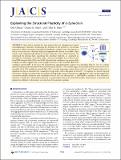Explaining the Structural Plasticity of α-Synuclein
Author(s)
Ullman, Orly; Fisher, Charles K.; Stultz, Collin M.
DownloadUllman-2011-Explaining the Structural Plasticity.pdf (4.407Mb)
PUBLISHER_POLICY
Publisher Policy
Article is made available in accordance with the publisher's policy and may be subject to US copyright law. Please refer to the publisher's site for terms of use.
Terms of use
Metadata
Show full item recordAbstract
Given that α-synuclein has been implicated in the pathogenesis of several neurodegenerative disorders, deciphering the structure of this protein is of particular importance. While monomeric α-synuclein is disordered in solution, it can form aggregates rich in cross-β structure, relatively long helical segments when bound to micelles or lipid vesicles, and a relatively ordered helical tetramer within the native cell environment. To understand the physical basis underlying this structural plasticity, we generated an ensemble for monomeric α-synuclein using a Bayesian formalism that combines data from NMR chemical shifts, RDCs, and SAXS with molecular simulations. An analysis of the resulting ensemble suggests that a non-negligible fraction of the ensemble (0.08, 95% confidence interval 0.03–0.12) places the minimal toxic aggregation-prone segment in α-synuclein, NAC(8–18), in a solvent exposed and extended conformation that can form cross-β structure. Our data also suggest that a sizable fraction of structures in the ensemble (0.14, 95% confidence interval 0.04–0.23) contains long-range contacts between the N- and C-termini. Moreover, a significant fraction of structures that contain these long-range contacts also place the NAC(8–18) segment in a solvent exposed orientation, a finding in contrast to the theory that such long-range contacts help to prevent aggregation. Lastly, our data suggest that α-synuclein samples structures with amphipathic helices that can self-associate via hydrophobic contacts to form tetrameric structures. Overall, these observations represent a comprehensive view of the unfolded ensemble of monomeric α-synuclein and explain how different conformations can arise from the monomeric protein.
Date issued
2011-10Department
Harvard University--MIT Division of Health Sciences and Technology; Massachusetts Institute of Technology. Department of Chemistry; Massachusetts Institute of Technology. Department of Electrical Engineering and Computer Science; Massachusetts Institute of Technology. Research Laboratory of ElectronicsJournal
Journal of the American Chemical Society
Publisher
American Chemical Society (ACS)
Citation
Ullman, Orly, Charles K. Fisher, and Collin M. Stultz. “Explaining the Structural Plasticity of α-Synuclein.” Journal of the American Chemical Society 133.48 (2011): 19536–19546. © 2011 American Chemical Society
Version: Final published version
ISSN
0002-7863
1520-5126